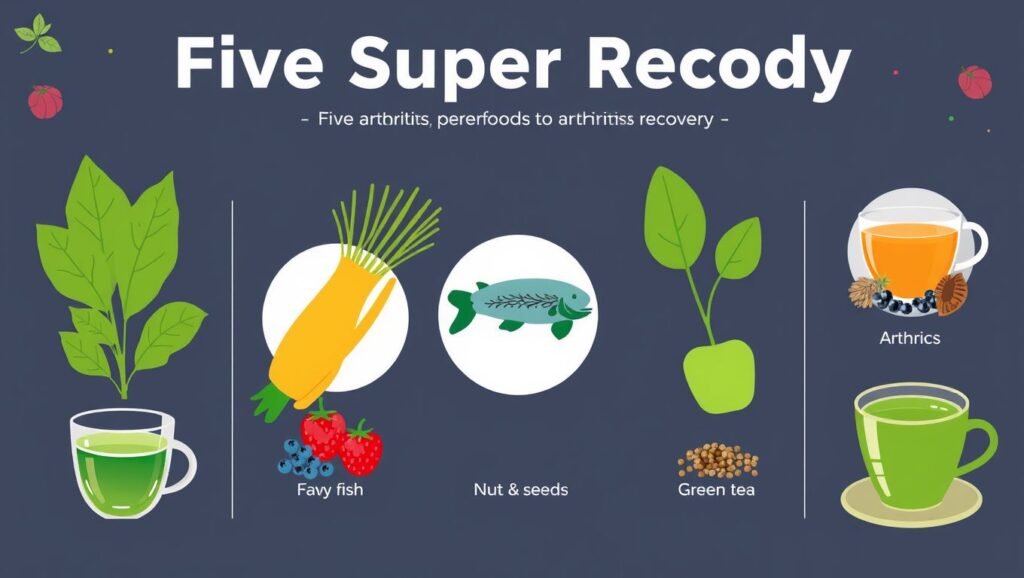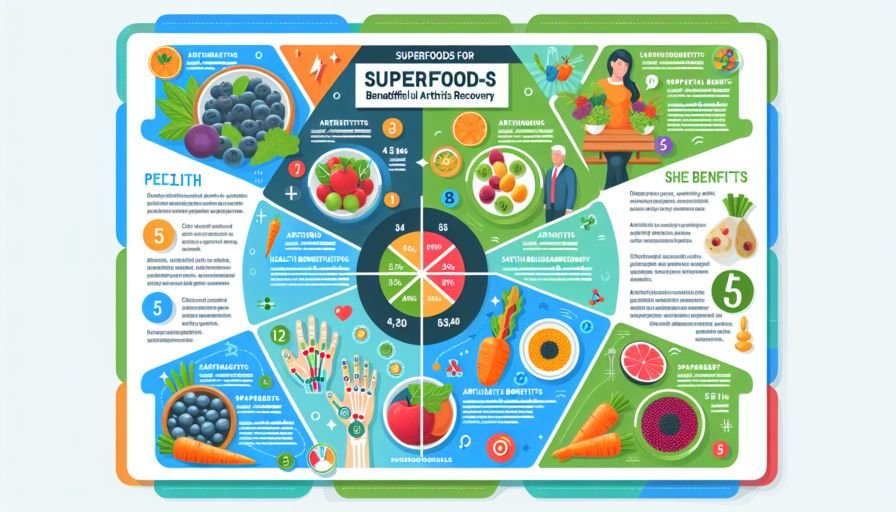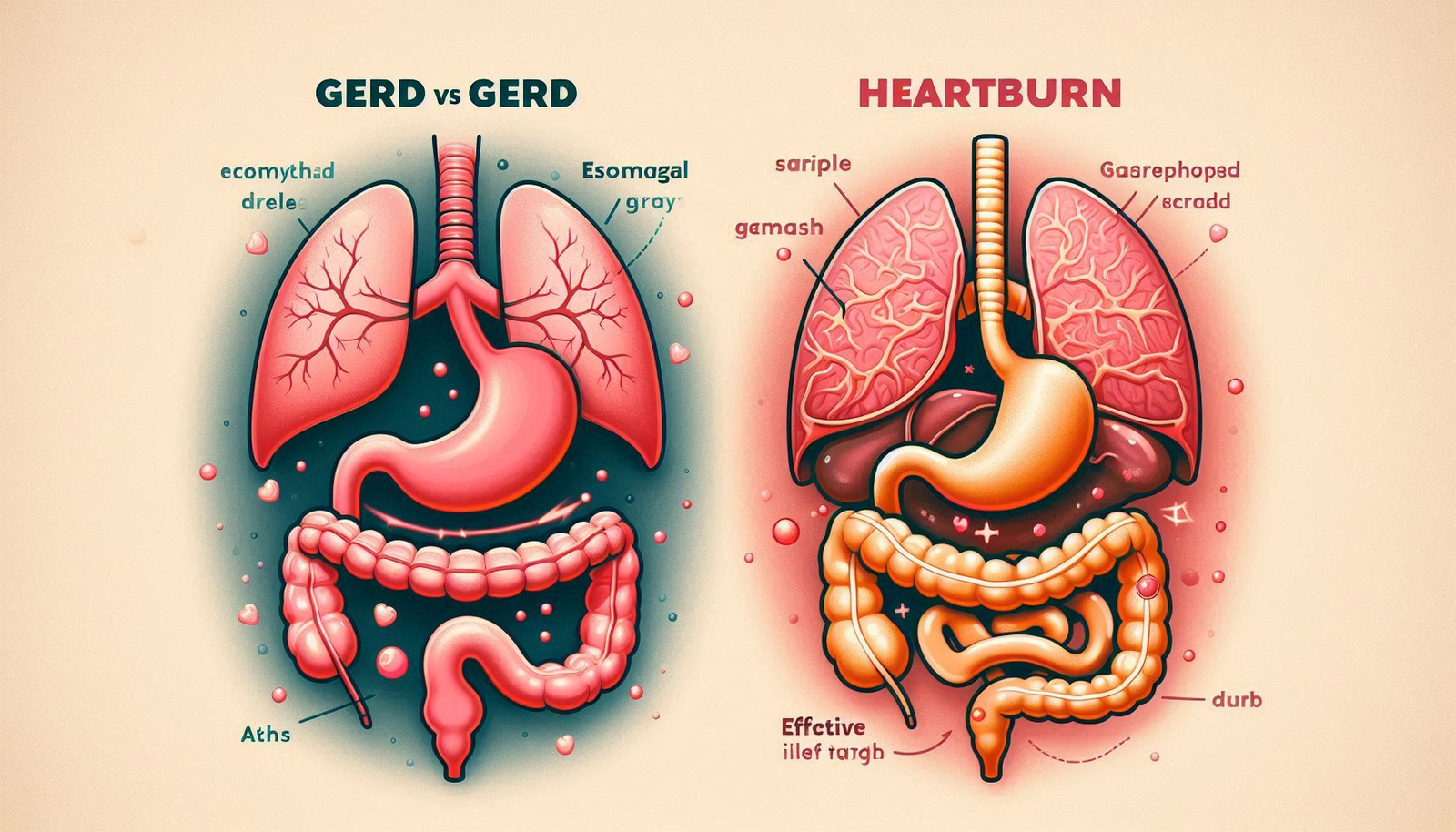
5 Amazing foods for an Effective Arthritis Recovery Diet
Discover five amazing foods, including leafy greens, to help ease joint pain and support your arthritis recovery journey.


Introduction
Brief Overview of Arthritis and Its Impact on Daily Life
Arthritis is a common condition that affects millions of people worldwide. It is characterized by inflammation of the joints, leading to pain, stiffness, and reduced mobility. Arthritis can significantly impact daily life, making simple tasks like walking, climbing stairs, or even holding objects challenging. The most common types of arthritis are osteoarthritis and rheumatoid arthritis, each with its own set of symptoms and causes. Managing arthritis effectively is crucial for maintaining a good quality of life and preventing further joint damage.
Importance of Diet in Managing Arthritis Symptoms
Diet plays a vital role in managing arthritis symptoms and promoting overall joint health. Certain foods have anti-inflammatory properties that can help reduce joint pain and inflammation, while others provide essential nutrients that support joint function and repair. Incorporating these foods into your diet can help alleviate arthritis symptoms, improve mobility, and enhance overall well-being. A balanced diet rich in anti-inflammatory and nutrient-dense foods is a natural and effective way to manage arthritis and support joint health.
Purpose of the Article
The purpose of this article is to highlight five amazing foods that can help ease joint pain and support arthritis recovery. By understanding the nutritional benefits of these foods and how they contribute to joint health, readers can make informed choices to improve their diet and manage arthritis symptoms more effectively.

1. Leafy Greens
Nutritional Profile of Leafy Greens
Leafy greens, such as spinach, kale, and Swiss chard, are packed with essential vitamins, minerals, and antioxidants. They are low in calories and high in fiber, making them an excellent addition to any diet. Here is a breakdown of the nutritional profile of one cup of cooked leafy greens:
Table: Nutritional Profile of Leafy Greens
| Nutrient | Amount per Serving (1 cup cooked) |
|---|---|
| Calories | 50 |
| Fiber | 4g |
| Vitamin K | 100% DV |
| Vitamin A | 80% DV |
| Antioxidants | High |
Benefits of Leafy Greens for Reducing Inflammation and Supporting Joint Health
Leafy greens are particularly beneficial for reducing inflammation and supporting joint health due to their high content of vitamins and antioxidants. Vitamin K, found abundantly in leafy greens, plays a crucial role in bone health and helps reduce inflammation. Vitamin A and other antioxidants help protect the joints from oxidative stress and damage. The fiber in leafy greens also supports overall digestive health, which is essential for nutrient absorption and reducing inflammation.
Scientific Studies Supporting the Benefits of Leafy Greens for Arthritis
Several scientific studies have highlighted the benefits of leafy greens for arthritis. Research has shown that a diet rich in leafy greens can help reduce markers of inflammation in the body, leading to improved joint health and reduced pain. Additionally, studies have found that the antioxidants in leafy greens can help protect the joints from oxidative damage, further supporting their role in managing arthritis symptoms.
Tips on Incorporating Leafy Greens into Your Diet for Arthritis Recovery
Incorporating leafy greens into your diet is easy and can be done in various ways:
- Salads: Add a variety of leafy greens to your salads for a nutrient-packed meal.
- Smoothies: Blend leafy greens into your smoothies for an easy and delicious way to boost your nutrient intake.
- Stir-Fries: Include leafy greens in your stir-fry recipes with other vegetables and proteins.
- Soups: Add leafy greens to soups and stews for added nutrition and flavor.
- Side Dishes: Serve steamed or sautéed leafy greens as a side dish with your meals.
By including leafy greens in your daily diet, you can enjoy their delicious taste while reaping the benefits of improved joint health and reduced inflammation.

2. Fatty Fish
Nutritional Profile of Fatty Fish
Fatty fish, such as salmon, mackerel, and sardines, are rich in omega-3 fatty acids, protein, and essential vitamins. These nutrients make fatty fish a powerful food for reducing inflammation and easing joint pain. Here is a breakdown of the nutritional profile of a 3-ounce serving of fatty fish:
Table: Nutritional Profile of Fatty Fish
| Nutrient | Amount per Serving (3 oz) |
|---|---|
| Calories | 200 |
| Protein | 1.5 g |
| Omega-3 | 1.5g |
| Vitamin D | 50% DV |
Benefits of Omega-3 Fatty Acids for Reducing Inflammation and Easing Joint Pain
Omega-3 fatty acids, found abundantly in fatty fish, have potent anti-inflammatory properties that can help reduce joint pain and inflammation. These healthy fats help decrease the production of inflammatory molecules in the body, leading to improved joint health and reduced pain. Additionally, omega-3 fatty acids support overall cardiovascular health, which is essential for maintaining good circulation and joint function.
Scientific Studies Supporting the Benefits of Fatty Fish for Arthritis
Several scientific studies have highlighted the benefits of fatty fish for arthritis. Research has shown that regular consumption of omega-3 fatty acids can help reduce markers of inflammation in the body, leading to improved joint health and reduced pain. Additionally, studies have found that omega-3 fatty acids can help improve joint mobility and reduce the need for pain medication in individuals with arthritis.
Tips on Incorporating Fatty Fish into Your Diet for Arthritis Recovery
Incorporating fatty fish into your diet is easy and can be done in various ways:
- Grilled Fish: Enjoy grilled salmon, mackerel, or sardines as a main course with your meals.
- Fish Tacos: Make fish tacos with your favorite toppings for a delicious and nutritious meal.
- Salads: Add cooked fatty fish to your salads for added protein and omega-3s.
- Soups and Stews: Include fatty fish in soups and stews for a hearty and anti-inflammatory meal.
- Fish Cakes: Prepare fish cakes with mashed potatoes and seasonings for a tasty and healthy dish.
By including fatty fish in your daily diet, you can enjoy their delicious taste while reaping the benefits of improved joint health and reduced inflammation.
3. Berries
Nutritional Profile of Berries
Berries, such as strawberries, blueberries, and raspberries, are packed with fiber, vitamins, and antioxidants. They are low in calories and high in nutrients, making them an excellent addition to any diet. Here is a breakdown of the nutritional profile of one cup of mixed berries:
Table: Nutritional Profile of Berries
| Nutrient | Amount per Serving (1 cup) |
|---|---|
| Calories | 85 |
| Fiber | 8 gg |
| Vitamin C | 24% DV |
| Antioxidants | High |
Benefits of Berries for Reducing Inflammation and Supporting Joint Health
Berries are particularly beneficial for reducing inflammation and supporting joint health due to their high content of vitamins and antioxidants. Vitamin C, found abundantly in berries, plays a crucial role in collagen production and helps reduce inflammation. The antioxidants in berries help protect the joints from oxidative stress and damage. The fiber in berries also supports overall digestive health, which is essential for nutrient absorption and reducing inflammation.
Scientific Studies Supporting the Benefits of Berries for Arthritis
Several scientific studies have highlighted the benefits of berries for arthritis. Research has shown that a diet rich in berries can help reduce markers of inflammation in the body, leading to improved joint health and reduced pain. Additionally, studies have found that the antioxidants in berries can help protect the joints from oxidative damage, further supporting their role in managing arthritis symptoms.
Tips on Incorporating Berries into Your Diet for Arthritis Recovery
Incorporating berries into your diet is easy and can be done in various ways:
- Smoothies: Add a handful of mixed berries to your smoothies for added fiber and antioxidants.
- Breakfast: Top your oatmeal, yogurt, or cereal with fresh or frozen berries.
- Snacks: Enjoy a bowl of mixed berries as a healthy and refreshing snack.
- Salads: Add berries to your salads for a sweet and nutritious addition.
- Desserts: Use berries in baking recipes, such as berry muffins, pies, and tarts.
By including berries in your daily diet, you can enjoy their delicious taste while reaping the benefits of improved joint health and reduced inflammation.
4. Nuts and Seeds
Nutritional Profile of Nuts and Seeds
Nuts and seeds, such as almonds, walnuts, chia seeds, and flaxseeds, are rich in healthy fats, protein, and essential vitamins. They are an excellent source of both soluble and insoluble fiber, making them a powerful food for digestive health. Here is a breakdown of the nutritional profile of one ounce of nuts and seeds:
Table: Nutritional Profile of Nuts and Seeds
| Nutrient | Amount per Serving (1 oz) |
|---|---|
| Calories | 160 |
| Protein | 5g |
| Healthy Fats | 14 g |
| Fiber | 3g |
Benefits of Nuts and Seeds for Reducing Inflammation and Supporting Joint Health
Nuts and seeds are particularly beneficial for reducing inflammation and supporting joint health due to their high content of healthy fats and antioxidants. The omega-3 fatty acids found in walnuts and flaxseeds have potent anti-inflammatory properties that can help reduce joint pain and inflammation. Additionally, the antioxidants in nuts and seeds help protect the joints from oxidative stress and damage. The fiber in nuts and seeds also supports overall digestive health, which is essential for nutrient absorption and reducing inflammation.
Scientific Studies Supporting the Benefits of Nuts and Seeds for Arthritis
Several scientific studies have highlighted the benefits of nuts and seeds for arthritis. Research has shown that regular consumption of nuts and seeds can help reduce markers of inflammation in the body, leading to improved joint health and reduced pain. Additionally, studies have found that the healthy fats and antioxidants in nuts and seeds can help protect the joints from oxidative damage, further supporting their role in managing arthritis symptoms.
Tips on Incorporating Nuts and Seeds into Your Diet for Arthritis Recovery
Incorporating nuts and seeds into your diet is easy and can be done in various ways:
- Snacks: Enjoy a handful of mixed nuts and seeds as a healthy and convenient snack.
- Salads: Add nuts and seeds to your salads for a crunchy and nutritious addition.
- Smoothies: Blend nuts and seeds into your smoothies for added protein and healthy fats.
- Baking: Use nuts and seeds in baking recipes, such as muffins, bread, and energy bars.
- Yogurt: Mix nuts and seeds into yogurt for a fiber-rich and nutritious snack.
By including nuts and seeds in your daily diet, you can enjoy their delicious taste while reaping the benefits of improved joint health and reduced inflammation.
5. Green Tea
Nutritional Profile of Green Tea
Green tea is a popular beverage that is rich in antioxidants and polyphenols. These compounds make green tea a powerful food for reducing inflammation and supporting joint health. Here is a breakdown of the nutritional profile of one cup of green tea:
Table: Nutritional Profile of Green Tea
| Nutrient | Amount per Serving (1 cup) |
|---|---|
| Calories | 2 |
| Antioxidants | High |
| Polyphenols | High |
Benefits of Green Tea for Reducing Inflammation and Supporting Joint Health
Green tea is particularly beneficial for reducing inflammation and supporting joint health due to its high content of antioxidants and polyphenols. These compounds help reduce the production of inflammatory molecules in the body, leading to improved joint health and reduced pain. Additionally, the antioxidants in green tea help protect the joints from oxidative stress and damage.
Scientific Studies Supporting the Benefits of Green Tea for Arthritis
Several scientific studies have highlighted the benefits of green tea for arthritis. Research has shown that regular consumption of green tea can help reduce markers of inflammation in the body, leading to improved joint health and reduced pain. Additionally, studies have found that the antioxidants and polyphenols in green tea can help protect the joints from oxidative damage, further supporting their role in managing arthritis symptoms.
Tips on Incorporating Green Tea into Your Diet for Arthritis Recovery
Incorporating green tea into your diet is easy and can be done in various ways:
- Hot Tea: Enjoy a cup of hot green tea as a soothing and anti-inflammatory beverage.
- Iced Tea: Prepare iced green tea for a refreshing and nutritious drink.
- Smoothies: Add brewed green tea to your smoothies for added antioxidants and flavor.
- Cooking: Use green tea as a base for soups and stews for added nutrition and flavor.
- Baking: Incorporate green tea powder (matcha) into baking recipes, such as muffins, cakes, and cookies.
By including green tea in your daily diet, you can enjoy its delicious taste while reaping the benefits of improved joint health and reduced inflammation.
Conclusion
Incorporating nutrient-dense foods into your daily diet is essential for managing arthritis symptoms and supporting joint health. The five amazing foods highlighted in this article—leafy greens, fatty fish, berries, nuts and seeds, and green tea—are all excellent choices for reducing inflammation and easing joint pain.
By making these foods a regular part of your diet, you can enjoy their numerous health benefits and improve your overall well-being. Remember, a balanced diet that includes a variety of anti-inflammatory and nutrient-dense foods is key to maintaining healthy joints and preventing further joint damage.
Additional Sections (Optional)
- DIY Recipes: Include a variety of DIY recipes using the highlighted foods.
- FAQs: Address common questions about the arthritis recovery diet, such as the benefits, usage, and potential side effects of the highlighted foods.
- Expert Interviews: Feature interviews with nutritionists or dietitians discussing the benefits of these superfoods for arthritis recovery.
Message Copilot
Message Copilot





One Comment
Pingback: